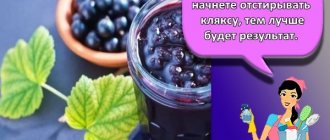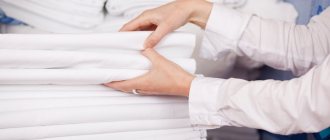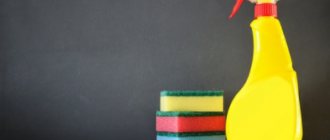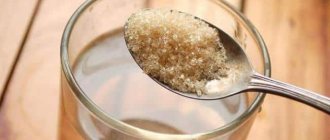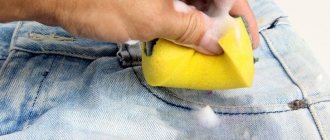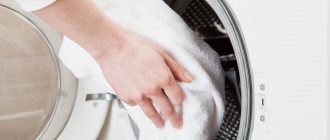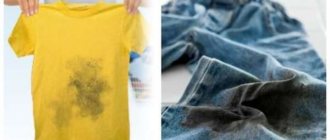Banana is, of course, a tasty and healthy product that is liked by both children and adults. But the softness of this fruit sometimes plays a cruel joke on us - before you know it, the banana breaks and falls on your favorite jeans, white T-shirt or bright dress.
Despite the fact that this fruit does not contain juice, it is capable of leaving complex stains on the fabric. You need to remove a banana stain immediately after you have placed it. If you hesitate, you will have to experiment a little with various stain-removing compounds and household chemicals.
Cold water instead of boiling water
Fresh stains from apples, pears, plums and many other fruits can be removed with boiling water. However, this trick will not work with banana spots.
You cannot wash clothes stained with banana in boiling water! Hot water will cause the stain that was light before washing to begin to darken and go deeper into the fibers of the fabric.
So if you notice a stain on your clothing, soak the item in cold water as soon as possible, and then after some time, wash the item by hand or in the washing machine on a standard cycle.
Lemon
We offer you another simple and affordable method for removing fresh dirt. Lemon juice is a real salvation for many housewives. This product is capable of removing a variety of stains from fabrics and surfaces. It will also help to wash bananas from children's things. Lemon juice can be used on colored items.
- Soak the stained item in cool water for 30 minutes.
- Apply a large amount of concentrated lemon juice to a fresh banana stain (you can rub the stain with a freshly cut citrus half).
- Rub the acid into the fabric and leave the item for 30 minutes. The allotted time is enough for the active substances of lemon juice to destroy organic compounds and remove banana pulp from tissue fibers.
Lemon is completely safe for skin, so you can safely use it as a stain remover for children's clothes.
Find out what other stains can be removed with lemon.
Soda and lemon juice
If the stain has already become ingrained, then regular baking soda comes to the rescue in the fight to keep things clean. The combination of baking soda and lemon juice is great for removing stains on colored and white items:
- Place the soiled item on a flat, hard surface so that you have easy access to the contaminated area.
- Sprinkle baking soda powder onto the stain until it completely covers it.
- Cut the lemon in half, squeeze the juice from half the citrus into soda.
- Wait for the two substances to react; the mixture should begin to sizzle. Leave the mixture on the dirt for 9-16 minutes.
- After preliminary removing the stains with baking soda and lemon juice, put the item in the washing machine and wash as usual.
- Dry the product thoroughly and, if necessary, repeat the removal procedure.
By the way, this method also works great on fresh red wine stains.
Leak search
To determine the location of the leak, you will have to partially disassemble the torpedo. Otherwise, you simply will not be able to get to the heater. This process is different for each machine. Therefore, it would be advisable to read the repair instructions for your specific model. This will avoid problems during operation. After providing access to the stove, diagnostics are performed.
First, inspect the heater valve
. Most cases of antifreeze getting into the interior occur due to leaks through it. The location of the leak is determined by touch. The problem point will be wet from antifreeze. Most often, the problem occurs at the joints between the faucet and the pipes. In this case, it is enough to change the gaskets. A little less often, the reason is in the tap itself. In this case, the leak will come from it. This problem is typical for old Opel and VAZ. But it can also occur on other machines. The only cure is to replace the entire faucet.
They also check the condition of the stove radiator. Sometimes it can leak. The reason is the peculiarities of the technical condition of this element. During operation, the walls of the radiator can become thinner, which leads to the formation of holes. Leakage can also be determined visually. Just in case, an additional examination of the radiator is carried out after its dismantling. This will avoid mistakes. If the hole is small, you can solder the part. This way you can save money on repairs. But this doesn’t always help, so sometimes it’s better to buy a new radiator right away.
Leak during repair
Sometimes you have to remove the heater core. This is done, for example, if there are problems with the stove. Even when the liquid is completely drained, some of it remains in the radiator. When removing the stove, you need to keep a suitable container ready. This will allow you to quickly drain the remaining antifreeze from the radiator. If this is not done, then the antifreeze will definitely end up under the rugs.
Domestos
This household chemical comes to the rescue when neither lemon juice, soda, nor regular washing with a stain remover could remove a banana stain from clothes. The product contains oxalic acid, which removes even the most complex stains.
Domestos should not be used on delicate or colored fabrics, as it can damage them. The use of the drug is permissible only on white fabrics. Be sure to protect your hands with rubber gloves when handling this cleaner.
What do we have to do:
- Apply a small amount of Domestos to the stain.
- Leave the item for 10 minutes so that the product has time to eat away the stain.
- Wash your clothes in the washing machine as normal. If you use Domestos to remove a stain from children's clothing, then when washing you need to set it to a double (or triple) rinse cycle so that the remaining detergent is completely washed out and does not cause a reaction on the child's sensitive skin.
Domestos can only be used on white fabric and in cases where nothing else helps to clean the item. The fact is that this aggressive agent thins the fibers of the fabric and it can tear faster.
Removing shiny marks from clothes depending on the type of fabric and color
Shiny marks on clothing are formed when the integrity of the upper structure of a fabric product is damaged; a vinegar-water solution will help restore it on light-colored clothing. To prepare it, you need to mix 25 ml of 9 percent vinegar with 75 ml of water. Dip all affected areas with the resulting mixture and sprinkle with fine salt. Wait until the fabric is completely dry and remove any remaining salt with a soft-bristled clothes brush or regular dishwashing sponge. After processing, it is recommended to iron the product.
If the whole thing begins to shine, then it can be completely soaked for 30 minutes in a vinegar solution, to obtain which you should dissolve one tbsp in three liters of warm water. a spoonful of vinegar. After which the treated fabric should be removed from the solution, wrung out and dried thoroughly without resorting to the rinsing procedure.
Iron marks can be removed from natural light-colored fabrics using bleach or a bleach solution. To do this, mix a teaspoon of bleach in one liter of water and treat all areas where shine has formed. It is worth noting that this method can have a negative effect on the structure of the fabric.
Next, let's look at how to remove iron stains with a characteristic shiny gloss from clothes in dark and black tones:
- Removing a shiny spot on items made from black fabrics is quite simple. It is recommended to thoroughly wet a piece of gauze with ammonia, vinegar or soap solution, apply it to the affected area and iron with the steam mode turned on.
- The use of a pumice stone or fine-grained sandpaper is considered to be effective in removing shine on black things, but they are recommended to be used only for cleaning rough or heavy fabrics.
- Lemon juice can also help eliminate shine on black and colored fabrics. To do this, squeeze a small amount of juice onto the stain and rub it with a nail file.
- Strongly brewed black tea drink is another way to get rid of gloss. It recommends soaking a piece of gauze, placing it on the affected area of clothing and steaming it using an iron.
To remove shiny stains from silk, chiffon and synthetics, baking soda will help, which should be diluted with a small amount of water to a mushy consistency. It is recommended to apply the resulting paste to the affected areas and let it dry completely. Then it is recommended to rinse the treated clothing, dry it and iron it thoroughly, but when ironing you should use only the delicate mode. This is necessary to prevent repeated damage to the silk or synthetic fabric structure.
It is recommended to simply spray a shiny velvet blouse with a powerful steam jet from the iron, without touching the sole of the household appliance to the surface of the fabric. While the fabric is still hot, it is recommended to use a stiff brush to treat problem areas, lifting the fibers.
The combination of ammonia and hydrogen peroxide is considered an excellent means of removing shine from synthetic fabrics. To do this, you need to mix hydrogen peroxide with ammonia in a ratio of 5:1
Soak a cotton pad, sponge, or sponge in the resulting solution and carefully treat all stains. Leave the product to dry completely and then rinse in water at room temperature.
White
One of the most aggressive chlorine-based stain removers. It can only be used on white items. Products made from delicate materials will not tolerate the use of such a product:
- Apply a small amount of White to the stain.
- Leave for one minute.
- After this, wash the item in the washing machine in double rinse mode.
Frequent use of chlorine bleaches leads to thinning of fabric fibers and it becomes more fragile.
How to remove foundation stains from clothes made of different materials
When choosing a cleaning method, be sure to consider the type and shade of fabric. The following table will help you understand the nuances of the process:
| Fabric type | Cleaning method and products |
| Natural white material | Chlorine bleaches, laundry soap |
| Silk | Gentle products and delicate stain removers |
| Synthetics (elastane, polyester, acrylic) | Liquid stain removers (“Antipyatin”, “Vanish”), washing at low temperatures |
| Jeans | Brush, home and household products that do not contain bleaching ingredients, dishwashing detergent, laundry soap |
| Wool | Starch, Antipyatin soap, micellar water, wash at a temperature of no more than +40 ℃ |
| White things | Stain removers with whitening properties (“BOS”), hydrogen peroxide |
| Fur | Cotton pad soaked in alcohol |
Using improvised products or household chemicals will help save your favorite item from traces of foundation. Before using any method, evaluate the fabric composition and color, and check the cleaning recommendations for the specific material. Remember, the sooner the “rescue operation” is started, the higher the chance of returning the clothes to their former cleanliness and freshness.
Stain remover from improvised means
If you don’t trust various store-bought stain removers from the mass market, then you can try making an excellent universal solution for removing stains at home using improvised products.
You will need:
- ½ tbsp. spoons of baking soda,
- 2 tbsp. spoons of hydrogen peroxide
- 1 tbsp. spoon of dishwashing liquid.
What to do:
- Mix all ingredients in a small container.
- Apply the prepared mixture to the stain, lightly rub it into the fabric and leave for 15-20 minutes.
- Wash the item by hand or in a washing machine on a standard cycle.
If you are afraid that hydrogen peroxide may damage delicate colored fabric, then apply the stain remover first to an inconspicuous place and watch the reaction of the material.
Features of washing children's clothes
Modern industry offers a wide selection of specialized stain removers. But caring for children's things is more difficult.
But there is another problem - mild drugs cannot always cope with their main task.
A serious problem when washing clothes is often the fact that stains from fruit juice or pulp cannot always be noticed in time. Subsequently, new stains are layered on top of the old ones, aggravating the problem. But it is still possible to remove fruit stains from a child’s clothes. To do this, you need to make some effort and act taking into account a few simple rules.
Conventionally, we can highlight some general recommendations for removing stains:
- Contamination from bananas, apples and other fruits should be washed off as quickly as possible. The older the contamination, the more difficult it is to remove it without leaving a trace.
- It is recommended to wash off fruit marks only with cold water. Using high temperature water helps stains penetrate deeper into the fibers.
- Any contamination will be removed more easily if it is first soaked for some time in water or soap solution.
- Before you start treating the stain, it is worth reading the recommendations on the clothing label. It is worth choosing products for removing stains taking into account the characteristics of the fabric, its color and composition.
Sunflower oil, oxygen bleach and powder
Another homemade stain remover that allows you to remove almost any type of stain without damaging the fabric.
To prepare the mixture you will need:
- 2 tbsp. spoons of sunflower oil,
- 2 tbsp. spoons of oxygen stain remover,
- 2 tbsp. spoons of regular washing powder.
What do we have to do:
- Pour about 5 liters of boiling water into a deep container (pan, bucket or basin).
- Add oil, laundry detergent and stain remover.
- Immerse the soiled items in the prepared hot solution and leave them there until the water cools completely.
- After this, rinse your clothes.
If the stain is fresh
There won't be the slightest trace of banana stains if you take action right away. To begin with, remove the remaining puree and rinse the trace under running cold water. After this, you can use home remedies:
- Laundry soap (72%). Dilute the detergent in warm water and soak the soiled clothes in it for 1 hour. To enhance the effect, pre-soap the stain. After time has passed, rub off the dirt. If it does not disappear, repeat the procedure. When the stain is completely discolored, wash the entire garment.
- Citric acid (or squeezed juice). The fruit acids contained in citrus will quickly discolor traces of bananas and will not harm the child’s health.
Procedure: place oilcloth under the stain, moisten it with water, sprinkle with powder, rub lightly so that the acids penetrate the fibers more actively.
Wait 15-20 minutes, rub again, rinse off the paste. Wash the item. Do the same with lemon juice: pour over the stain and leave to sit. At the end - washing.
Soda. Prepare a paste by mixing the powder with water. Apply to the stained area and leave for an hour. Whip off the dried soda and wash the item.
Effective stain removers
You can also use ready-made oxygen stain removers to remove banana stains. They are gentler on fabrics than chlorine, and many of them can be used on colored clothing.
- Dr.Beckmann Fruits and drinks with active oxygen;
- Mepsi baby care stain remover for children's clothing;
- Antipyatin;
- Astonish OXY PLUS;
- Bleach BOS plus Maximum for white clothes.
Despite the fact that bananas do not contain such bright colors as, for example, blueberries, raspberries, oranges and other fruits. Traces from them still eat into the fabric and remain on it as an unaesthetic yellow or brown stain. Such contaminants must be dealt with immediately after they appear to avoid deep penetration into the fabric fibers. To fight, you can use both folk recipes and store-bought stain removers.
How to remove old banana marks
In cases where yellow fruit stains were not noticed in time or appeared outside the home, it is more difficult to deal with them. But there are folk recipes for such cases.
Salt, soda, vinegar
Even after a long time after the stain has formed, it can be removed with cheap means, which can be found in any kitchen with an almost one hundred percent guarantee. An effective stain remover recipe:
- mix table salt and baking soda in a one to one ratio;
- moisten the powder to a paste;
- apply to contamination;
- let it soak in, leave until dry;
- rub the stain, brushing off any remaining powder;
- neutralize the alkali with 9% vinegar solution.
The final step should be machine or hand washing using washing powder.
Hydrogen peroxide
Three percent hydrogen peroxide is the ancestor of oxygen bleaches; it helps to cope with banana stains, even slightly dried ones. The stain needs to be treated with a double-sided lotion from an effervescent solution by applying napkins or cotton pads soaked in the solution to the stain. The procedure lasts up to half an hour, then the peroxide must be washed off. Sometimes one session is not enough, and the procedure will have to be repeated after the textile has dried.
We recommend:
How to make terry towels soft and fluffy after washing
Note! Hydrogen peroxide is not suitable for all types of fabrics, so it is better to first test the product on an inconspicuous area of the soiled item.

